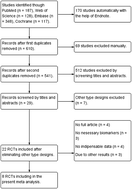The combination effect of vitamin K and vitamin D on human bone quality: a meta-analysis of randomized controlled trials†
Abstract
Background: Previous studies did not draw a consistent conclusion about the effects of vitamin K combined with vitamin D on human skeletal quality. Method and findings: A comprehensive search on Web of Science, PubMed, Embase and the Cochrane Library (from 1950 to February 2020) and bibliographies of relevant articles was undertaken, with the meta-analysis of eight randomized controlled trials (RCTs) including a total of 971 subjects. Vitamin K combined with vitamin D significantly increased the total bone mineral density (BMD): the pooled effect size was 0.316 [95% CI (confidence interval), 0.031 to 0.601]. A significant decrease in undercarboxylated osteocalcin (−0.945, −1.113 to −0.778) can be observed with the combination of vitamin K and D. Simultaneously, subgroup analysis showed that K2 or vitamin K (not specified) supplement was less than 500 μg d−1, which when combined with vitamin D can significantly increase the total BMD compared with the control group fed a normal diet or the group with no treatment (0.479, 0.101 to 0.858 and 0.570, 0.196 to 0.945). Conclusions: The combination of vitamin K and D can significantly increase the total BMD and significantly decrease undercarboxylated osteocalcin, and a more favorable effect is expected when vitamin K2 is used.



 Please wait while we load your content...
Please wait while we load your content...